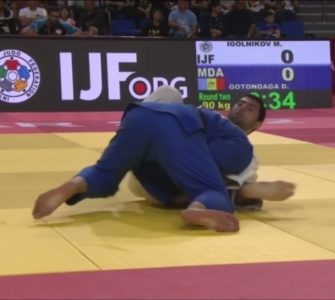In Judo there are 40 established traditional throws. The modifications of these 40 throws are virtually limitless, as each specific individual person will have strengths and weaknesses due to their own specific body mechanics and will have to modify throws to fit their needs.
Recently there has been more attention given towards Judo within the Jiu Jitsu community. While not all Judoka have a sincere depth of knowledge for groundwork, they do usually have an understanding of two things: throwing and pace.
Judo Groundwork
Not much time is allotted for groundwork in Judo. A single throw that utilizes power, control, and places an opponent directly on his back can award a win or Ippon in Judo competition. If a throw lacks in any one of these three necessities for an Ippon, the match then turns to groundwork. However, if the referee officiating the match deems that not progression is being made in quick fashion both players are forced to stand up and continue fighting on their feet.
While this sort of set of rules does not give room to develop interesting techniques such as the berimbolo or inverted guard (although many Judo players would probably love to know how to execute them!) it does instill other values. Initiative and Aggression.
Not sure if you have heard of her but here is a highlight of Ronda Rousey. In this Jiu Jitsu competition, she utilizes an abundance of Judo throws that advance her position on the ground:
Ronda Rousey Competing at Jiu-Jitsu No-Gi Grappling Tournament
Judo throws in Jiu Jitsu
Let’s just be honest, Judo throws are awesome. And as they are awesome, they are also very difficult to master. Big throws whether in Judo or Jiu Jitsu warrants admiration and applause. In Jiu Jitsu competition it also awards two points and typically an advantageous position to attack for a submission.
Big throw attempts don’t always end with a complete throw. A defensive standing posture in Judo warrants a penalty and can actually lead to a loss. So does stalling. But this is not true for Jiu Jitsu competition. It can be much harder to throw an unwilling combatant who does not engage than it is to throw an active one that is also aiming for a takedown. Especially for beginners in Judo, throws can be reversed or even missed, leaving the person leading the attack in a disadvantageous position. There is a risk versus reward element in attempting a throw, and without proper time set aside for intense drilling and executing of these standing techniques the risk may actually outweigh the reward for Jiu Jitsu competition.
I am discussing this element not to discourage the use Judo to try and win in Jiu Jitsu, but to actually highlight the overlooked benefits of learning Judo values (initiative and aggression) to supplement training in grappling.
Judo for Groundwork
Utilizing constant pressure and constant threat are great attributes to have in grappling. Learning judo can help develop this. Great examples of elite Jiu Jitsu competitors who leverage their success with a judo background and mentality are Andre Galvao and Raphael Lovato Jr.
The mentality of always striving to relentlessly pass guard and to push the attack leads into keeping your opponent on the defensive. Not only can this be physically exhausting for your competitor but it can also be mentally exhausting, especially if they are not accustomed to that sort of intense initiative and aggression.
Raphael Lovato Jr. has a serious background in Judo. And it shows. Check out his match at Metamoris where he utilizes serious aggression and pressured passing to not only pass guard but also to take initiative to gain position for an immediate kimura submission directly after the initial pass. Take a look.
In this article hope I was able to explain the benefits that training in Judo can have on your Jiu Jitsu game. Not just the Judo throws to gain points for a takedown and the potential to land in a dominant position, also the mental aspect of Judo that can help develop your ground work to be more aggressive based when it comes to passing guard and taking advantage of openings for the position and submission.
Don’t limit your takedown arsenal, learn Judo Leg Grabs with Shintaro Higashi.
- There is a reason that major tournaments banned leg grabs, they are TOO effective!
- Perfect for Jiu-Jitsu athletes where leg grabs are permitted.


















